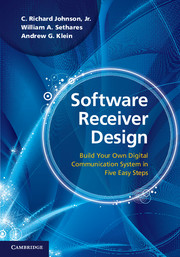15 - Make It So
from Step 5 - Putting It All Together
Published online by Cambridge University Press: 05 June 2012
Summary
This chapter describes a software-defined-radio design project called M6, the Mix ‘n’ Match Mostly Marvelous Message Machine. The M6 transmission standard is specified so that the receiver can be designed using the building blocks of the preceding chapters. The DSP portion of the M6 can be simulated in Matlab by combining the functions and subroutines from the examples and exercises of the previous chapters.
The input to the digital portion of the M6 receiver is a sampled signal at intermediate frequency (IF) that contains several simultaneous messages, each transmitted in its own frequency band. The original message is text that has been converted into symbols drawn from a 4-PAM constellation, and the pulse shape is a square-root raised cosine. The sample frequency can be less than twice the highest frequency in the analog IF signal, but it must be sufficiently greater than the inverse of the transmitted symbol period to be twice the bandwidth of the baseband signal. The successful M6 Matlab program will demodulate, synchronize, equalize, and decode the signal, so it is a “fully operational” software defined receiver (although it is not intended to work in “real time”). The receiver must overcome multiple impairments. There may be phase noise in the transmitter oscillator. There may be an offset between the frequency of the oscillator in the transmitter and the frequency of the oscillator in the receiver. The pulse clocks in the transmitter and receiver may differ.
Information
- Type
- Chapter
- Information
- Software Receiver DesignBuild your Own Digital Communication System in Five Easy Steps, pp. 342 - 356Publisher: Cambridge University PressPrint publication year: 2011
